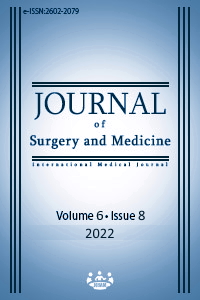Characteristic and management of pediatric arachnoid cysts: A case series
Pediatric arachnoid cysts
Keywords:
Arachnoid cysts, Conservative management, Craniotomy, Cysto-peritoneal shunting, Microsurgical cyst fenestrationAbstract
Background/Aim: Arachnoid cysts (ACs) are the collection of fluid, which is similar in composition to cerebrospinal fluid, within the congenitally duplicated arachnoid membrane. ACs are clinically silent lesions, but sometimes they can manifest themselves with headache, convulsion, focal neurological deficits, cognitive decline, torticollis, and macrocephaly. Although the appropriate surgical approach is less clear, there is a consensus on the need for surgical treatment in symptomatic ACs. This study aims to reveal the advantages and disadvantages of cystoperitoneal shunt and microsurgical fenestration techniques.
Methods: One hundred ninety-one consecutive patients from 1 month to 15 years old with AC were evaluated for suitability. Sixteen patients who underwent surgery were included in the study. Medical records of the patients with AC managed at our institutions were retrospectively collected and analyzed. Sixteen of 191 patients underwent surgical treatment via craniotomy for microsurgical cyst fenestration (CF) and cysto-peritoneal shunting (CS). CF was performed with partial cyst wall excision in all patients.
Results: Seizure was the most common presentation in the patients, followed by headache and trauma, respectively. In our series the most common indications of the surgery were increased intracranial pressure (IICP). CF was performed in nine patients, and CS was performed in seven as the primary treatment. CS-related complications, such as infection (n = 2), dysfunction (n = 2) and intraabdominal abscess (n = 1) were the most commonly observed complications. No infections were observed after CF, but subdural hematoma was observed in one child.
Conclusions: Although the most common symptoms in cases with arachnoid cysts are headache, rare symptoms, such as torticollis, may exist. Due to this, clinicians should reveal the cyst-complaint relationship first. Given the increased complications of CS, in addition to shunt independency and being free from shunt-related complications, the microsurgical CF with wide excision of the membranes seems to be the more preferable surgical option.
Downloads
References
Cincu R, Agrawal A, Eiras J. Intracranial arachnoid cysts: current concepts and treatment alternatives. Clin Neurol Neurosurg. 2007;109:837-43. DOI: https://doi.org/10.1016/j.clineuro.2007.07.013
Gosalakkal JA. Intracranial arachnoid cysts in children. A review of pathogenesis, clinical features, and management. Pediatr Neurol. 2002;26:93-8. DOI: https://doi.org/10.1016/S0887-8994(01)00329-0
Al-Holou WN, Yew AY, Boomsaad ZE, Garton HJL, Muraszko KM, Maher CO. Prevalence and natural history of arachnoid cysts in children. J Neurosurg Pediatrics. 2010;5:578-85. DOI: https://doi.org/10.3171/2010.2.PEDS09464
Zarina SA, Lang SS, Bakar D, Storm PB, Stein SC. Pediatric intracranial arachnoid cysts: comparative effectiveness of surgical treatment options. Childs Nerv Syst. 2014;30:461-9. DOI: https://doi.org/10.1007/s00381-013-2306-2
Alexiou GA, Varela M, Sfakianos G, Prodromou N. Shunting for the treatment of arachnoid cysts in children. Neurosurgery. 2010;67:1632-6. DOI: https://doi.org/10.1227/NEU.0b013e3181f94476
Boutarbouch M, El Ouahabi A, Rifi L, Arkha Y, Derraz S, El Khamlichi A. Management of intracranial arachnoid cysts: Institutional experience with initial 32 cases and review of the literature. Clin Neurol Neurosurg. 2008;110:1-7. DOI: https://doi.org/10.1016/j.clineuro.2007.08.009
Halani SH, Safain MG, Heilman CB. Arachnoid cyst slit valves: The mechanism for arachnoid cyst enlargement. J Neurosurg Pediatrics. 2013;12:62-6. DOI: https://doi.org/10.3171/2013.4.PEDS12609
Mori K, Yamamoto T, Horinaka N, Maeda M. Arachnoid cyst is a risk factor for chronic subdural hematoma in juveniles: Twelve cases of chronic subdural hematoma associated with arachnoid cyst. J Neurotrauma. 2002;19:1017-27. DOI: https://doi.org/10.1089/089771502760341938
Tumturk A, Kaya Ozcora G, Kacar Bayram A, Kabaklioglu M, Doganay S, Canpolat M, et al. Torticollis in children: an alert symptom not to be turned away. Childs Nerv Syst. 2015;31:1461-70. DOI: https://doi.org/10.1007/s00381-015-2764-9
Per H, Canpolat M, Tümtürk A, Gumuş H, Gokoglu A, Yikilmaz A, et al. Different etiologies of acquired torticollis in childhood. Childs Nerv Syst. 2014;3:431-40. DOI: https://doi.org/10.1007/s00381-013-2302-6
Kang JK, Lee KS, Lee IW, Jeun SS, Son BC, Jung CK, et al. Shunt-independent surgical treatment of middle cranial fossa arachnoid cysts in children. Childs Nerv Syst. 2000;16:111-6. DOI: https://doi.org/10.1007/s003810050024
Wang C, Han G, You C, Liu C, Wang J, Xiong Y. Individual surgical treatment of intracranial arachnoid cyst in pediatric patients. Neurol India. 2013;6:400-05. DOI: https://doi.org/10.4103/0028-3886.117618
Chernov MF, Kamikawa S, Yamane F, Hori T. Double-endoscopic approach for management of convexity arachnoid cyst: case report. Surg Neurol. 2004;61:483-7. DOI: https://doi.org/10.1016/S0090-3019(03)00574-3
Duz B, Kaya S, Daneyemez M, Gonul E. Surgical Management strategies of intracranial arachnoid cysts: A single institution experience of 75 cases. Turkish Neurosurg. 2012;22:591-8. DOI: https://doi.org/10.5137/1019-5149.JTN.5616-11.0
Rizk E, Chern JJ, Tagayun C, Tubbs RS, Hankinson T, Rozzelle C, et al. Institutional experience of endoscopic suprasellar arachnoid cyst fenestration. Childs Nerv Syst. 2013;29:1345-7. DOI: https://doi.org/10.1007/s00381-013-2032-9
Karabagli H, Etus V. Success of püre neuroendoscopic technique in thetreatment of Sylvian arachnoid cysts in children. Childs Nerv Syst. 2012;28:445-52. DOI: https://doi.org/10.1007/s00381-011-1632-5
Di Rocco F, James SR, Roujeau T, Puget S, Sainte-Rose C, Zerah M. Limits of endoscopic treatment of sylvian arachnoid cysts in children. Childs Nerv Syst. 2010;26:155-62. DOI: https://doi.org/10.1007/s00381-009-0977-5
Choi JW, Lee JY, Phi JH, Kim SK, Wang KC. Stricter indications are recommended for fenestration surgery in intracranial arachnoid cysts of children. Childs Nerv Syst. 2014;31:77-86. DOI: https://doi.org/10.1007/s00381-014-2525-1
Cinalli G, Spennato P, Ruggiero C, Aliberti F, Trischitta V, Buonocore MC, et al. Complications following endoscopic intracranial procedures in children. Childs Nerv Syst. 2007;23:633-44. DOI: https://doi.org/10.1007/s00381-007-0333-6
Beems T, Grotenhuis JA. Long-term complications and definition of failure of neuroendoscopic procedures. Childs Nerv Syst. 2004;20:868–77. DOI: https://doi.org/10.1007/s00381-004-0945-z
Downloads
- 629 1836
Published
Issue
Section
How to Cite
License
Copyright (c) 2022 Abdulfettah Tümtürk , Nimetullah Alper Durmuş , Süreyya Burcu Görkem , Murat Çiftçi , Mehmet Canpolat , Hüseyin Per
This work is licensed under a Creative Commons Attribution-NonCommercial-NoDerivatives 4.0 International License.
















